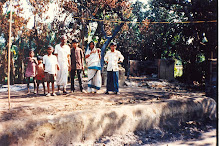Centenary of Colonial Religious Partition [1]
Sachi G. Dastidar
A century ago today, October 16, 1905, the Colonial British Administration in India partitioned a multi-religious, multi-ethnic, multi-linguistic, tolerant Bengal into a ‘Muslim’ East Bengal and ‘Hindu’ West Bengal: sort of bureaucratic 9/11 in India with devastating long-term consequences. Its polarizing result was the rise of intolerant Islam and religious politics that the British Administration promoted till it resulted in the partition of India and Bengal in 1947. (Indian provinces of Assam, Punjab and Kashmir were also partitioned.) In 1905 Bengal was not much different from the rest of Colonial India in terms of her Muslim-non-Muslim relation — which was rather amicable — but for its intense pro-Indian independence activism. Bengal of eastern India was the first to be colonized by the British, and she was the first to rebel against colonial slavery. In Bengal, Muslims and Hindus, with their small Buddhist and Christian cousins, shared not only the language but also religious festivals, dress, music, food and social bond. A large number of Bengali Hindus, Brahmos, Christians, Muslims, Buddhists — scholars, social reformers, spiritualists, nationalists, poets, musicians — from early 1800s to mid-1900s championed Mother India’s freedom. Among them were Raja Ram Mohon, Vidyasagar, Bankim Chandra, Rabindranath Tagore, W.C. Bonerjea, Vivekananda, Michael Madhusudan, Kazi Nazrul Islam, Sri Aurobindo, Begum Rokeya and Pritilata Waddedar. Lord Curzon witnessing the rise of Indian nationalism devised the first Colonial divide-and-rule policy by enticing a non-native Urdu-speaking Muslim feudal lord, Nawab Salimullah, of Dhaka, now the capital of Bangladesh, to promote a Muslim party against Indian independence movement with huge funds — 300,000 rupees — from the treasury. He argued that Bengal was too large to govern from its capital Calcutta, also India’s capital then, but no explanation was given why a geographical separation was not proposed instead of communal division when every village was inhabited by Muslims and Hindus. Curzon also proposed to give some favors to ‘backward Muslims’ instead of proposing a one-man one-vote democracy which could have brought Muslim-majority to power through ballot box. Moreover, there were other large provinces which were not partitioned. After much agitation by mostly non-Muslim poets, writers and activists Bengal was reunited in 1912 but that partition would energize a separatist, intolerant Islamist movement and a separatist Muslim identity that would take millions of lives and displace tens of millions from East Bengal, now called Bangladesh, alone. By 1947 the East Bengali Muslim majority would became a champion of partition of India. At India’s independence in 1947 Bengal was partitioned following the same 1905 British-invented line. Later Britain would use divide-and-rule from North Ireland to South Africa, from Ceylon to Cyprus. That tolerant Muslim East Bengal of 1905 is now Bangladesh where ‘Islam is the Official Religion’ with pro-Taliban parties as ruling partners, and West Bengal is a state of India run by hard-line Bangladeshi Hindu privileged-caste bhadralok refugee communists. Since that fateful day in 1905 Muslim-non-Muslim conflict became routine in the Subcontinent. On the eve of India’s independence in 1946, also on October 16, on the auspicious Hindu Lakhsmi Puja day a ghastly anti-Hindu pogrom began in the eastern Noakhali district under the watchful eyes of British Raj, Colonial Army, Bengal’s Muslim League Premier Suhrawady and it’s capital Calcutta’s (Muslim) Mayor Osman to polarize the nation. The pogrom was led by a Muslim Legislator Golam Sarwar that took life of thousands of Hindus and tens of thousands of Hindu girls and wives were abducted and converted. The pogrom followed a Muslim-Hindu riot in Calcutta two months earlier. Both these killings were to convince the British Raj and Indian public that Muslims and non-Muslims cannot live together. Successive anti-Hindu pogroms in East Pakistan/ Bangladesh have dwindled her Hindu minority from a third of the population in 1947 to less than 10% now resulting in over 48 million ‘missing from the Census.’ Minority Muslim population in Hindu-majority West Bengal has risen from 18% to 26% in spite of massive influx of Hindu refugees from Bangladesh. With the steady rise of intolerant Saudi Islamism in Bangladesh (Pakistan and Afghanistan) for the past 100 years common tradition of festivities, literature, food and dress have been changing with serious repercussion for non-Muslims and secularist Muslims. Ironically in 1971 the same Islamically-charged East Bengal/East Pakistan, then the majority of Pakistan, rebelled for a secular state — first ever by a Muslim-majority nation — opposed by Pakistan, Saudi Arabia, other Muslim nations, China and the Administration of President Nixon-Kissinger. In 1975 Islamists took revenge by brutally murdering the pro-secular Founding Father Mujibur Rahman with 25 others of his family and friends, many there believe, with our support. In a twist of fate from that British-created event, tragedies hit British soil exactly 100 years later in July of this year through the children of Britain’s former intolerant allies. Spirit of Curzon must be wondering if Britain would have been better off with ethnically cleansed, religiously pure society or with pluralism and tolerance.
[1] News-India Times (a New York weekly), October 14, 2005; 2-3
Subscribe to:
Post Comments (Atom)

1 comment:
If possible, contact me. we are trying to form an org for the upliftment of BENGALI HINDUS for their economic benefit.
Post a Comment